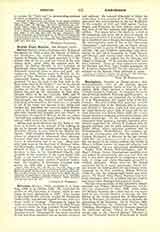

Birmingham, Diocese of (BIRMINGHAMIA, BIRMINGHAMIENSIS).—One of the thirteen dioceses erected by the Apostolic Letter of Pius IX, September 27, 1850, which restored a hierarchy to the Catholic Church in England. It comprises the counties of Oxford, Stafford, Warwick, and Worcester. It takes its name from the municipal city of Birmingham in Warwickshire, the largest town of the four counties. Previous to 1850, these same four counties were included, first in the Midland, then in the Central, District or Vicariate, which had been governed by vicars-Apostolic since 1688, of whom by far the most illustrious was Bishop Milner (1803-26)—a man equally learned in polemics, ecclesiastical history, and sacred archaeology. To his untiring energies and undaunted front against a strongly organized schismatical opposition, the Church in England owes its present stability and its solid ecclesiastical unity. Under Milner, whose episcopal residence was at Wolverhampton (Staffordshire), this vicariate became the starting-point and then the center of the Catholic Movement, or Revival, in the last century (1800-50). Its prominence as well as its lustre was due not merely to its central position, but chiefly to Milner’s brilliant talents, his magnetic influence, and clear foresight. Its two educational establishments—Sedgley Park School, Wolverhampton, and St. Mary’s College, Oscott, Birmingham—presided over and staffed by exceptionally able men, lent their aid also to this great movement by supplying a zealous body of clergy and a laity thoroughly grounded in Catholic principles. When, later on, the Oxford movement led to so many conversions, Oscott College became the rallying point for the Catholic forces, inasmuch as its then president, Bishop Wiseman (1840-17), was the acknowledged leader and interpreter. To Oscott John Henry Newman had come from Littlemore after his reception into the Church, and many other distinguished converts besides.
The last vicar-Apostolic of this henceforth historic vicariate was William Bernard Ullathorne, O.S.B., who was consecrated June 21, 1846. After ruling the Western Vicariate for a short time he was translated to the Central District, to become the first Bishop of the newly created See of Birmingham. Next to Wiseman, he had done most to promote the restoration of the hierarchy. On October 27, 1850, Bishop Ullathorne was enthroned in St. Chad’s Cathedral, Birmingham, when Dr, Newman preached his celebrated sermon “Christ on the Waters”, second only to the “Second Spring” delivered at the First Provincial Synod of Westminster at Oscott (July, 1852). The cathedral and bishop’s house had been erected in Bishop Walsh’s vicariate (June 21, 1840) from designs drawn by Augustus Welby Pugin, the foremost promoter of the revival of Gothic architecture, who, through the munificence of John, 16th Earl of Shrewsbury, adorned the diocese with many ecclesiastical buildings. Over the high altar of St. Chad’s Cathedral rest the relics of its patron which had been enshrined till the Reformation in Lichfield Cathedral. On June 24, 1852, the cathedral chapter, consisting of a provost and ten canons, was duly erected, to which three honorary canons have since been added. The first and third provosts, respectively, were Msgr. Weedall, D.D., and Dr. Northcote, both presidents of Oscott. The first diocesan synod was held 9 and November 10, 1853, since which time there have been thirteen other synods (1853-1906). In 1873, owing to refusal to renew the lease, Sedgley Park School was transferred to St. Wilfrid’s, Cotton, Staffordshire, formerly the residence of Father Faber and the Oratorians. In the October of the same year St. Bernard’s Diocesan Seminary was opened at Olton, Warwickshire, of which the first rector was the Rev. Edward Ilsley, successively canon and bishop-auxiliary (December 4, 1879).
In July, 1887, Bishop Ullathorne resigned, becoming Titular Archbishop of Cabasa. He retired to Oscott, where he died March 21, 1889. Two persons stand forth conspicuous in the history of the Birmingham diocese whose relations with Bishop Ullathorne were exceptionally close, Cardinal Newman and Mother Margaret Hallahan. The former lived and died at the oratory, Edgbaston, Birmingham, and the new basilica opened October 9, 1906, will perpetuate his memory. The latter was the foundress of the English Congregation of Nuns of the Third Order of St. Dominic, who have convents and. hospitals at Stoke on Trent and Stone. The latter is the burying place both of Archbishop Ullathorne and Mother Margaret. The large number of communities of women who have found a home in this diocese attracted by the personality of Bishop Ullathorne include Benedictines (2 abbeys, 3 priories), Poor Clares, Little Sisters of the Poor, Sisters of Mercy and of St. Paul—the latter introduced from Chartres by Mother Genevieve Dupuis. Another religious force, specially characteristic of the diocese, has been the annual reunions in the Town Hall, Birmingham, which, begun in 1855, have been presided over by eminent Catholics, and have tended to keep the clergy and laity in touch with one another. Mention, too, must be made of John Hardman of Birmingham, whose firm has done so much in promoting ecclesiastical art, notably stained-glass and metal work, and whose benefactions to the cathedral choir have enabled it to reach a standard of excellence in church music which places it first among Catholic choirs. On February 17, 1888, Dr. Ilsley became the second Bishop of Birmingham, and at once took in hand the difficult task of protecting and rescuing the destitute Catholic children of the diocese. St. Edward’s Home for homeless boys was opened at Coleshill (Warwickshire), November 6, 1906, with branch houses for boys and girls, similarly situated, in various centers, besides a Home for Working Boys and a Night Refuge, both in Birmingham. In July, 1889, Oscott College was closed to lay students and reopened as a Central Seminary for ecclesiastics only. The progress of Catholicism since 1850 is gauged by a comparison of a few statistics for the years 1851 and 1906, respectively: clergy, 124 and 297; churches, 82 and 189; religious communities, 19 and 97.
JOHN CASWELL

